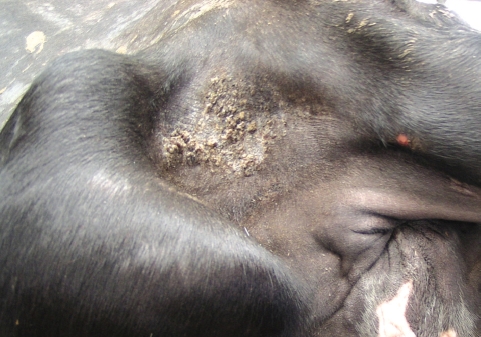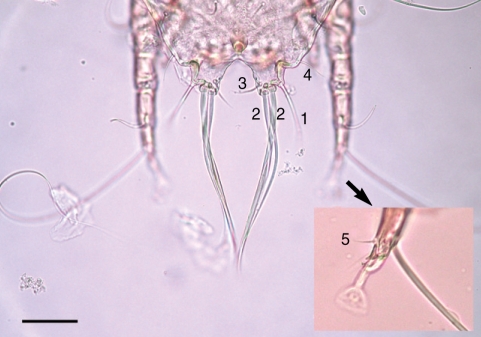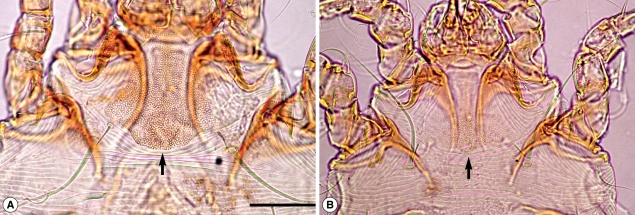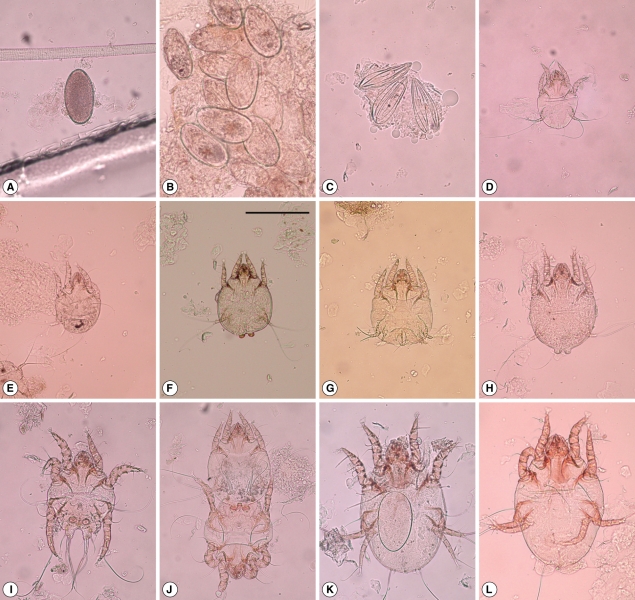Abstract
Mites in the genus Chorioptes cause a mild form of skin disease in both domestic and wild ruminants. In July 2006, dermatitis characterized by alopecia, marked lichenification, accumulation of crust, and fissuring was recognized in 14 out of 200 Holstein dairy cattle raised in the cattle farm of the National Institute of Animal Science in Cheonan, Republic of Korea. Skin lesions were distributed mainly over the tail base, and sacral and perineal regions. Microscopic examinations of skin scraping samples from severely affected areas revealed numerous mites of all developmental stages. Morphologically, pedicels of the mites were short and unjointed. The tarsal suckers occurred on the pedicels of all the legs in the male worm and on the first, second, and fourth pair of legs in the adult female worm. A single long seta at the tarsus of legs III and the length of legs II being about twice as long as legs IV in adult male mites were observed. Arising anterior to the inner-most spatulate seta was a short seta with an average of 26.4 ± 5.8 µm in length. Also, the length of setae #4 on the opisthosomal lobes was relatively short. Based on these observations, the mites were identified as Choriptes texanus. Although the chorioptic mange may not influence the mortality rate in the affected farm, reports indicate that a decline in milk production can be observed. This is the first report of chorioptic infestation in a cattle farm from Korea.
-
Key words: Chorioptes texanus, mite infestation, cattle, Korea
INTRODUCTION
Chorioptic mange is a skin disease of both domestic and wild ruminants caused by
Chorioptes spp. (Acari: Psoroptidae) which are obligatory, non-burrowing mites that pass all stages on the host [
1]. It can cause irritation, localized dermatitis, and self-trauma due to pruritus, and is currently considered to be the most common form of cattle mange in many countries in the Northern Hemisphere. Sweatman [
2,
3] described two major species of
Chorioptes,
C. bovis (Hering, 1845) Gervais, 1859 and
C. texanus Hirst, 1924, after detailed biologic and morphologic studies of the genus collected from many ungulates. Although numerous chorioptic species have been designated according to their hosts, the biological, morphological, and molecular genetic studies indicate that only
C. bovis and
C. texanus are distinctively valid species [
4]. Morphologically, these two species differ in the shape and length of the opisthosomal setae of the adult males [
3]. The validity of 3 other species,
C. crewei Lavoipierre, 1958,
C. mydaus Fain, 1975, and
C. panda Fain and Leclerc, 1975, is still regarded as questionable because discrimination of mites, which were described as isolated cases only, were based on morphological features while transfer or crossbreeding studies were not done [
4]. A new pathogenic
Chorioptes species that was morphologically and genetically distinct from previously reported species was recently reported to cause inflammation in the outer ear canals of moose (
Alces alces) originated from Sweden [
5].
C. bovis can cause lesions characterized by an exudative dermatitis on the lower legs and scrota of rams and has been stated that scrotal mange affects ram fertility [
6]. However, chorioptic mites generally elicit a milder, superficial form of mange in cattle compared to severely pruritic mange caused by
Sarcoptes spp. and
Psoroptes spp. Chorioptic mites live on the surface of the skin feeding on epidermal material, but neither burrow into the skin nor pierce the skin [
7]. While most
Chorioptes spp. are rarely found in the ears of the hosts,
C. texanus was considered to be a primarily auricular mite in reindeers (
Rangifer tarandus) [
3].
Within the Southeast Asian countries, both
C. bovis and
C. texanus have been reported to infest dairy and beef cattle in Japan [
8], and
C. bovis in a wild Japanese serow [
9].
C. texanus was also observed in goats from Malaysia [
10]. However, their presence in Korea has never been reported. Herein, we report an outbreak of dermatitis in a cattle reproduction farm in Korea caused by
C. texanus with a description of a minor discrepancy in morphological features compared to those of previous reports.
CASE RECORD
In July 2006, dermatitis characterized by alopecia, marked lichenification, accumulation of crust, and fissuring was recognized in 14 out of 200 Holstein dairy cattle raised in the cattle farm of the National Institute of Animal Science in Cheonan, Korea. Skin lesions were distributed over the tail base, sacral region, and areas of the hind udder. The body surface of the affected animals was characterized by alopecia, marked lichenification, accumulation of crust, and fissuring. Most seriously affected skin regions were up to 1 cm thick with cauliflower-like growth masses (
Fig. 1).
For parasitological examination, skin scraping samples from severely affected areas were collected and fixed in 70% methanol. Mites in scrapings collected from the edges of active lesions were counted as described by Rehbein et al. [
7]. Scrapings were made using a sharp spoon from an area approximately 3 × 3 cm, and 6 sites were scraped on each animal. Mites were extracted from these samples and mounted on slides with Down's PVA solution [
11]. Diagnosis of the mites to the genus
Chorioptes was made according to the key provided by Fain [
12], and the differentiation of species was based on a key given by Fain and Leclerc [
13]. The length of opisthosomal setae 1, 2, and 3 located at the posterior end of the opisthosomal lobes, seta 4 from the caudal body margin between the opisthosomal lobe and the 4th leg, and seta 5 located at tarsus III, were measured in 20 adult male mites (seta numbering according to Sweatman [
3]).
Microscopic examination of scrapings revealed various stages of parasitic mites from 10 out of 14 affected animals (71.4%). The number of mites collected varied from 1 to 5,237 with an average of 1,007.2 mites per animal (data not shown). Body parts of 20 mites of each life stage, i.e., adult male, adult female, nymph male, nymph female, larva, and egg, were measured using an ocular micrometer. The protonymph and deutonymph stages of male and female mites were not differentiated in the measurement of the nymphal stages. Measurements of body parts in each life stage are shown in
Table 1. Comparative lengths of setae on adult male mites collected from the Holstein cattle in this study with those of male mites reported by Sweatman [
3] and Hestvik et al. [
5] are provided in
Table 2.
All developmental stages of mites, from the egg to adult stages, were observed from samples collected from affected cattle (
Fig. 2). Morphologically, pedicels of the mites were short and unjointed. Tarsal suckers occurred on the pedicels of all legs in the adult male and on the first, second, and fourth pair of legs in the adult female. A single long seta at the tarsus of legs III and the length of legs II being about twice as long as legs IV in adult male mites were observed. Based on these observations, the mites were identified as the genus
Chorioptes.
The adult males had 2 prominent abdominal lobes on the posterior end. The opisthosomal lobes were as long as wide, and bore 5 setae. In the center of the posterior end of the lobe bore 3 long setae with 1 in the center the longest (213.0 ± 15.1 µm), whereas the other 2 were identical in length (setae #2 in
Fig. 3, 172.3 ± 8.9 µm) and were spatulated in shape at the distal end. The outer spatulate seta did not have the conspicuous hook towards the proximal end which was a characteristic feature of
C. bovis [
3]. Each opisthosomal lobe had a primary lobe with an outer, smaller accessory lobe forming a small angle with relation to the main lobe. The accessory lobe gave rise to a short, fine seta (seta #1 in
Fig. 3) with an average length of 61.1 ± 8.0 µm from the outer corner of the opisthosomal lobe on the same plane as the prominent spatulated setae (setae #2 in
Fig. 3).
Arising just anterior to the innermost spatulate seta was a short seta (seta #3, 26.4 ± 5.8 µm) which was a characteristic feature of
C. texanus. Its counterpart in
C. bovis was 4 times longer and arises more anteriorly [
3]. Lateral to the opisthosomal lobes, the dorsum ended posteriorly in a small, but distinct point. Arising just outside from the point was a short seta (26.6 ± 4.8 µm, setae #4 in
Fig. 2) which was also a different feature compared to that of
C. bovis in which the corresponding seta was close to 3 times longer. The single ventral seta of tarsus III was short and measured 20.3 ± 7.5 µm (setae #5 in
Fig. 2). These data together indicated that the mites infested on the Holstein cattle in this report were
C. texanus according to the description of Sweatman [
3].
Contrary to the shape of the elongated propodosomal plate of
C. bovis reported by Shibata et al. [
9] and Sweatman [
2], the length and width of the propodosomal plate of all developmental stages in this report were similar in length which measured 82.1 × 80.3 µm in adult female and 58.3 × 61.5 µm in adult male (
Table 1). Furthermore, while Sweatman [
2] recorded that the propodosomal plate of adult male was often pointed posteriorly, such features was not observed in
C. texanus in this report. The projection pattern of the posterior base line of the porpodosomal plates in both male and female adult mites was rather broad than pointed in the center (
Fig. 4).
DISCUSSION
C. texanus has so far been isolated from both domestic and wildlife animals including goats in Texas, reindeer in Canada, cattle in Brazil, Israel, Germany, and USA, and elks in Poland [
4]. In the Southeast Asian countries,
C. texanus has been reported to infest cattle and goats from Japan [
8] and Malaysia [
10], respectively.
C. texanus isolated from the Holstein cattle from Korea in this report was morphologically identical to
C. texanus reported by Sweatman [
2] except for the shape of the propodosomal plates of adult female and adult male mites. Contrary to the pointed propodosomal plate posteriorly described by Sweatman, the length and width of the propodosomal plate of
C. texanus isolated from the Holstein cattle from Korea was similar. This morphological difference, however, does not appear to be significant enough to separate into a new species.
The taxonomic status of
C. texanus is based on the morphological characteristics of male mites which differ from
C. bovis by the opisthosomal lobes and their setae. Male mites of
C. texanus have paired opisthosomal lobes, each consisting of a primary lobe with an outer, smaller secondary lobe, whereas
C. bovis has undivided lobes. Furthermore, while the spatulate setae of
C. texanus are almost twice as long as those of
C. boivs, the fine seta at the outer corner of each opisthosomal lobe in
C. texanus is distinctly shorter than its counterpart in
C. bovis which contrasted with 4 times longer, thick seta in the same position [
3]. While the outer spatulate seta of
C. bovis has a conspicuous hook towards the proximal end, it is absent on
C. texanus. Sweatman's bipartitie classification of the genus
Chorioptes was confirmed genetically by Essig et al. [
14] who characterized the second internal transcribed spacer of the rRNA gene extracted from 14 isolates of
Chorioptes spp. using primers RIB-4 and RIB-3. Although 3 additional
Chorioptes spp.,
C. crewei Lavoipierre, 1958,
C. mydaus Fain, 1975, and
C. panda Fain and Leclerc, 1875, were described after Sweatman’s revision in 1957, their validity is considered questionable, because features used for discriminating these taxons were not convincing and no transfer or cross-breeding studies were done [
4]. Recently Hestvik et al. [
5] reported a previously unidentified
Chorioptes species infesting the outer ear canals of the moose (
Alces alces) which differ morphologically and genetically from other
Chorioptes species.
C. bovis has been reported to infest the feet of horses, sheep, and goats in the Netherlands [
15], and in a wild Japanese serow [
9].
C. texanus has been found on the body of domestic goats in Texas [
16], the ears of reindeers (
Rangifer tarandi) [
3] in Canada, cattle in Brazil [
17], Israel [
1,
14,
18], Germany, and USA [
14], gazelles (
Gazella gazelle) in Israel [
1], and from elks (
Alces alces) in Poland [
19,
20]. These indicate that both
C. bovis and
C. texanus have a broad host range.
Unlike skin diseases of cattle caused by
Sarcoptes and
Psoroptes mites, the chorioptic mange generally elicits milder symptoms probably because chorioptic mites neither burrow nor pierce the skin. Cases of herd infections frequently occur during winter season, and are typically observed in the adult age group, especially in milking-age cows. Clinical signs include crusty lesions in the root of the tail and the grooves on either side, and tend to be localized with moderate pruritus present. Initially starting with a varnished surface, later the affected area is covered with fine, dry scales which can spread towards the perineum, escutcheon, inner sides of the thighs, and fetlocks [
7]. Irritation and itching become intense when lesions extend in size and coalesce to form crusts and heavy scabs that can spread even to the sacral region and the udder. Although the Chorioptic mange may not influence the affected farm economically, reports indicate that a decline in milk production can be observed [
21].
Since this is the first report of chorioptic mite infestation in Korea, we propose the Korean name of the genus Chorioptes as Pibujindeugi and as Texaspibujindeugi for the Korean name of the species C. texanus. We also propose the Korean name for C. bovis as Sopibujindeugi.
ACKNOWLEDGEMENTS
This study was supported by an Endemic Diseases Control Program of the National Institute of Health, Ministry of Health and Welfare, Republic of Korea (NIH-4800-4847-302).
References
Fig. 1Dermatitis of a Holstein cow showing crusts and heavy scabs in the ischiorectal fossa due to Chorioptes texanus infestation.

Fig. 2Light micrographs of various developmental stages of Chorioptes texanus. (A) Unembryonated egg. (B) Numerous eggs, each containing a fully developed larva. (C) Empty egg shells, (D) Ventral view of a larvae (no sexual dimorphism). (E) Dorsal view of a male protonymph. (F) Dorsal view of a female protonymph. (G) Ventral view of a male deutonymph. (H) Dorsal view of a pubescent female ( =female deutonymph). (I) Ventral view of an adult male. (J) An attachment pair. Pubescent female above and adult male below. (K) Ventral view of an ovigerous female ( =adult female) containing an egg. (L) Dorsal view of an adult female. Bar = 200 µm

Fig. 3Light micrograph of an adult male
Chorioptes texanus sampled from Holstein cattle in Korea, showing the caudal end with opisthosomal lobes. Measurements for the numbered setae are presented in
Table 2. Seta numbering according to Sweatman [
3].
Bar = 50 µm.

Fig. 4Propodosomal plates of Chorioptes texanus; (A) adult female, (B) adult male. Bar = 100 µm.

Table 1.Measurements of each life stage of Chorioptes texanus from the Holstein cattle from Korea
Table 1.
|
Egg |
Larva |
Nympha
|
Adult
|
|
Male |
Female |
Male |
Female |
|
Length |
166.0 ± 12.9 |
180.8 ± 15.5 |
232.0 ± 38.5 |
231.1 ± 36.1 |
239.0 ± 14.6 |
373.5 ± 32.7 |
|
(150-190) |
(150-210) |
(170-295) |
(173-310) |
(220-265) |
(325-440) |
|
Width |
88.5 ± 14.0 |
124.5 ± 13.9 |
169.8 ± 22.4 |
181.3 ± 25.5 |
198.8 ± 8.4 |
239.6 ± 42.4 |
|
(65-110) |
(100-155) |
(133-205) |
(135-240) |
(185-220) |
(113-300) |
|
Dorsum length |
- |
142.3 ± 19.2 |
190.9 ± 35.7 |
190.0 ± 33.1 |
191.1 ± 13.3 |
315.5 ± 34.2 |
|
|
(105-170) |
(135-250) |
(138-270) |
(175-213) |
(255-380) |
|
Propodosomal plate length |
- |
47.4 ± 12.8 |
50.0 ± 6.0 |
53.1 ± 8.1 |
58.3 ± 8.5 |
82.1 ± 5.9 |
|
|
(33-90) |
(38-63) |
(38-68) |
(40-70) |
(70-90) |
|
Propodosomal plate width |
- |
39.4 ± 6.2 |
53.9 ± 6.8 |
57.6 ± 5.9 |
61.5 ± 7.0 |
80.3 ± 5.8 |
|
|
(30-55) |
(38-65) |
(48-68) |
(48-73) |
(68-90) |
|
Gnathosoma width |
- |
38.0 ± 5.4 |
48.5 ± 5.0 |
50.1 ± 5.0 |
53.5 ± 3.1 |
71.4 ± 7.1 |
|
|
(30-48) |
(38-58) |
(43-60) |
(50-63) |
(63-80) |
Table 2.Comparative length of setae on adult male mites of Chorioptes texanus from the Holstein cattle in Korea
Table 2.
|
Setal No. |
Setal length (μm)
|
|
1 |
2 |
3 |
4 |
5 |
|
C. texanus from Canadian reindeer [3] |
|
|
|
|
|
|
Range |
66-98 |
193-235 |
27-39 |
23-27 |
14-29 |
|
Mean |
80 |
216 |
31 |
25 |
18 |
|
SD |
7.5 |
10.2 |
2.9 |
1.4 |
3.3 |
|
N |
20 |
20 |
20 |
20 |
20 |
|
C. texanus from Sweden cattle [5] |
|
|
|
|
|
|
Range |
37-69 |
145-185 |
13-32 |
16-32 |
8-40 |
|
Mean |
54.2 |
164 |
24.3 |
24.9 |
18.3 |
|
SD |
7.3 |
8 |
5.4 |
3.9 |
7.2 |
|
N |
40 |
40 |
31 |
38 |
35 |
|
C. texanus from Korean cattle [this study] |
|
|
|
|
|
|
Range |
35-75 |
160-200 |
15-37.5 |
17.5-35 |
7.5-40 |
|
Mean |
61.1 |
172.3 |
26.4 |
26.6 |
20.3 |
|
SD |
8 |
8.9 |
5.8 |
4.8 |
7.5 |
|
N |
20 |
20 |
20 |
20 |
20 |










